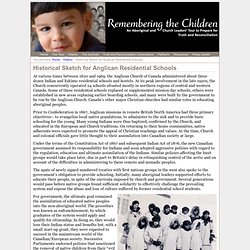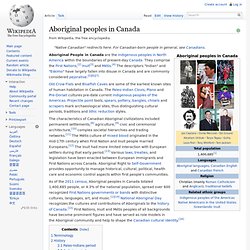

Residential schools. A class at a resendential school. Aboriginal children learning about relegion. Historical Sketch for Anglican Residential Schools. At various times between 1820 and 1969, the Anglican Church of Canada administered about three dozen Indian and Eskimo residential schools and hostels.

At its peak involvement in the late 1920s, the Church concurrently operated 24 schools situated mostly in northern regions of central and western Canada. Some of these residential schools replaced or supplemented mission day schools, others were established in new areas replacing earlier boarding schools, and many were built by the government to be run by the Anglican Church.
Canada’s other major Christian churches had similar roles in educating aboriginal peoples. Prior to Confederation in 1867, Anglican missions in remote British North America had three primary objectives-- to evangelize local native populations, to administer to the sick and to provide basic schooling for the young. WIKIPEDIA Pages. Canadian Indian residential school system. There has long been significant historiographical and popular controversy about the conditions experienced by students in the residential schools.

While day schools for First Nations, Metis and Inuit children always far outnumbered residential schools, a new consensus emerged in the early 21st century that the latter schools did significant harm to Aboriginal children who attended them by removing them from their families, depriving them of their ancestral languages, sterilization, and exposing many of them to physical and sexual abuse at the hands of staff and other students, and enfranchising them forcibly.
History[edit] The foundations of the system were the pre-confederation Gradual Civilization Act (1857) and the Gradual Enfranchisement Act (1869). These assumed the inherent superiority of British ways, and the need for Indians to become English-speakers, Christians, and farmers. At the time, many Aboriginal leaders wanted these acts overturned.[9] St. Mortality rates[edit] Native American Society. All Nations Canoe Gathering - line-up of vessels. WIKIPEDIA Pages. Aboriginal peoples in Canada. The characteristics of Canadian Aboriginal civilizations included permanent settlements,[8] agriculture,[9] civic and ceremonial architecture,[10] complex societal hierarchies and trading networks.[11] The Métis culture of mixed blood originated in the mid-17th century when First Nation and Inuit people married Europeans.[12] The Inuit had more limited interaction with European settlers during that early period.[13] Various laws, treaties, and legislation have been enacted between European immigrants and First Nations across Canada.

Aboriginal Right to Self-Government provides opportunity to manage historical, cultural, political, health care and economic control aspects within first people's communities. Terminology[edit] The terms First Peoples and First Nations are both used to refer to indigenous peoples of Canada.[17] The terms First Peoples or Aboriginals in Canada are normally broader terms than First Nations, as they include Inuit, Métis and First Nations. History[edit] Aboriginal peoples choice music awards. Native & American Indian News, Culture, Music, Art and More - Indian Country Today Media Network.com. The Official Idle No More Website - Idle No More.
Aboriginal Peoples Television Network (APTN) - APTN.ca - Home Page. Nativemax.